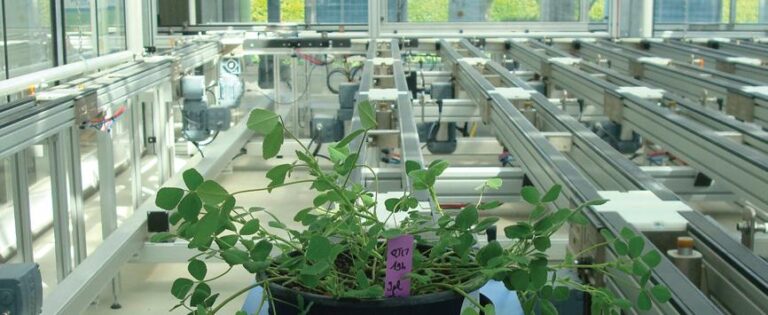Near Dijon in France, hundreds of plants move along a robotic conveyor belt around a football pitch-sized compound. At various points along their motorised journey they are fed, weighed, photographed and x-rayed, offering huge amounts of computerised data from leaf to root.The Dijon plant laboratory is one part of a multi-locational EU-funded project called ABSTRESS – involving the Czech Republic, Germany, Spain, France, Italy, Hungary, and the United Kingdom – which is trying to lessen Europe’s dependence on imported animal feed by identifying other naturally grown drought- and disease-resistant substitutes.“‘Some of the environmental problems arising from feed importation are quite horrific.’Adrian Charlton, the ABSTRESS project leader from the United Kingdom’s FERA‘Protein sustainability in Europe is an absolutely huge problem. We rely on imported soya protein from South America for between 70 % and 80 % of all protein that goes into animal feed,’ Adrian Charlton, the ABSTRESS project leader from the United Kingdom’s Food and Environment Research Agency (FERA), said.The reason protein-rich leguminous plants are not extensively cultivated in Europe for animal feed is because they are susceptible to disease, drought, and other environmental changes.At least 11 % of Europe’s population and 17 % of its territory has been affected by water scarcity, putting the cost of droughts in Europe over the past thirty years at EUR 100 billion, the European Commission said in a preamble to its 2012 Water Scarcity and Droughts Policy Review. It added that it expects further deterioration of the water situation in Europe if temperatures keep rising as a result of climate change.Until new plant varieties can be grown that are able to withstand this scarcity of water, Europe continues to import soya beans. In 2011 alone, the EU imported more than 12 million tonnes of soya beans, over ten times more than it produced, according to the most recent data from FEDIOL, an industry organisation.Adrian Charlton, the ABSTRESS project leader. © ABSTRESSAdrian Charlton, the ABSTRESS project leader. © ABSTRESSThat’s why the five-year ABSTRESS project is working to change the way in which new plant varieties are produced, by using molecular and computational techniques to identify drought and disease-resistant crop strains. ‘What we are looking for is which genes are switched on for drought and fungus. We have to catch the gene expression at exactly the right time to identify the resistant genes,’ Charlton said.The researchers use clover-like plants called Medicago truncatula to look for the traits they want. Once they have found the right characteristics, they cross breed them into top-performing species, and then they test them against commercial crops.This method of filtering for natural genes underlines a significant aspect of this project: its search for a solution free from genetically modified organisms (GMOs).By the time it finishes at the end of 2016, the project hopes to have made plants that are more resistant to drought and disease, and in the process to have developed high-tech ways of selecting plants for specific traits.DeforestationIf they get it right, the ABSTRESS researchers’ work could at the same time help remove a major source of damage to the environment: deforestation. ‘Some of the environmental problems arising from feed importation are quite horrific: a lot of the deforestation that has occurred in South America has been to make way for soya crops,’ Charlton said.In addition, Europe’s large-scale importation of such a relatively low-value soya crop is incurring a giant carbon footprint, the European Feed Manufacturers’ Federation said in a 2012 report. Sourcing animal feed through vegetables grown in the EU would help to reduce this phenomenon.The techniques that ABSTRESS is developing could also be used to identify other genetic varieties of foods that are resistant to drought and disease. Cultivating these on a mass scale would be hugely advantageous in terms of both food production and lowering the carbon footprint, especially if they were all grown naturally, too.
This article was originally published in Horizon, the EU Research and Innovation magazine.
Add to favorites:
Share:
Listing Description
Video
Documents
No documents available.
Ask KETMarket to make a contact
Connect with the Listing Owner!
💬 Please log in now to askKETMarket to make a contact. Not a member yet? Sign up for free and start connecting today!
Video
Related Funding and Finance Opportunities
Unlock Exclusive Funding Opportunities!
🔑 Get instant access to tailored funding opportunities that perfectly match your needs. This powerful feature is exclusively available to our premium members—helping you save time, stay ahead of the competition, and secure the right funding faster.
Upgrade to Premium now and never miss an important opportunity again! Already a premium member? Log in here to explore your matches.
Related Innovation Offers
Discover Tailored Innovation Offers!
🚀 Gain access to technology solutions that match your specific needs and interests—carefully selected to support your innovation goals. These offers are exclusively available to our premium members, helping you identify relevant technologies faster and start the right conversations with potential partners.
Upgrade to Premium now and explore your personalized technology matches today! Already a premium member? Log in here to view your tailored offers.
Related Knowledgeable Resources
Discover More with Premium: Related Knowledge Resources
🔒 You’re missing out on expert-curated knowledge specifically matched to this topic. As a Premium member, you gain exclusive access to in-depth articles, guides, and insights that help you make smarter decisions, faster.
Whether you’re preparing a funding proposal, researching a new market, or just need reliable information—our Premium knowledge matches save you hours of research and point you directly to what matters.
Upgrade to Premium now and instantly unlock relevant knowledge tailored to your needs! Already a member? Log in here to view your personalized content.

